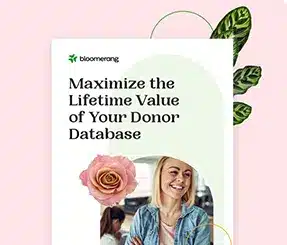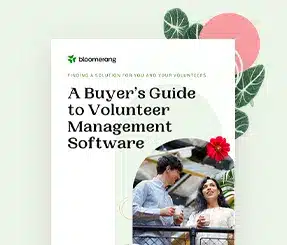Donor database buyer’s guide: Tips for nonprofit success


Full Platform Overview Chat With Us



Full Platform Overview Chat With Us




A donor database is much more than a glorified phonebook for nonprofits. The right donor management tools are an incredible asset for optimizing fundraising, expanding donor stewardship, and forming long-lasting relationships.
In the 2024 State of the Nonprofit Sector Report, 74% of organizations reported job vacancies. At the same time, 71% of nonprofits saw increased demand for their programs and services. Donor database software helps improve your team’s capacity by automating processes and saving time, allowing you to keep your focus on mission-critical projects and initiatives.
In this guide, we’ll explore everything you need to know about donor databases so you can choose the right solution for your nonprofit. Here’s what we’ll cover:
Carefully read through each step before making this significant investment decision for your nonprofit. Let’s get started.
A donor database is software that nonprofit professionals use to gain insights into their supporters’ engagement histories, track key fundraising metrics, and measure success.
Along with storing donors’ contact and demographic information, this technology helps build relationships with supporters by saving previous engagement data, such as past donations or attended events. This functionality allows nonprofits to build on past interactions and organically grow relationships.
Your nonprofit might already use a variety of tools to manage donor relationships. You may wonder, “What’s the advantage of investing in another software solution on top of our existing solutions?” A donor database offers the following benefits:
A donor database takes your nonprofit’s fundraising to the next level, ensuring you can sustainably manage and grow supporter relationships over time.
Now that you know the advantages of a donor database, it’s time to choose the right solution for your nonprofit. There are three primary considerations when searching for a new donor database: basic, next-level, and tailored features unique to your organization.
Any effective donor database will contain a few essential features for helping your organization stay on target. To effectively keep donor data organized, manage reports, and enable data segmentation, you should look for a donor database with the following necessary features:
These are standard features that your organization will find in any quality donor database. If a donor database doesn’t have these features, steer clear. Chances are, you’ll grow out of the solution very quickly.
In addition to these necessary features, your nonprofit should also keep an eye out for the unique features of each platform that help maintain long-lasting donor relationships. Here are a few additional features that will support your nonprofit’s goals:
Platforms like Bloomerang offer these built-in special features, so you can easily leverage them to identify new fundraising opportunities and reach supporters with personalized messages. Bloomerang even allows you to track volunteer and member engagement using the same system, consolidating all need-to-know supporter information in one place.
Because every nonprofit is different, there may be some tools that you’d benefit from, while other organizations won’t see the same positive results.
To determine the unique list of features that will benefit your specific organization, follow these steps:
Identifying your nonprofit’s most essential features will help keep you organized and focused as you develop lists of potential solutions and narrow them down.
There are many nonprofit donor databases out there, all claiming to be the best. How can you decide which is best for your organization? Research.
You’ll need to conduct a lot of research about your organization’s needs and the various systems available to decide which one is the right choice. Here are the research steps we suggest:
Choosing a donor database does take a lot of time and research. However, that time is well worth spending up front because the right solution will serve your nonprofit effectively for years.
To help kick-start your donor database research, we’ve compiled a list of seven top solutions to consider:
Overview: Bloomerang CRM offers all of the features nonprofits need in their day-to-day activities and additional special features to level up their fundraising. The software solution’s design is rooted in the technical expertise of world-renowned fundraising consultants and practitioners.
Top features: Bloomerang was explicitly developed to improve donor retention and relationship-building strategies for nonprofits.
Bloomerang’s unique features include:
Bloomerang’s expert knowledge of and passion for the nonprofit space mean their donor database software is superior to the average solution.
Plus, Bloomerang’s donor database integrates seamlessly with its fundraising platform. That means users who leverage both the donor database and online fundraising tools can easily capture all donor data from their digital donation page, automatically add it to new or existing donor profiles, and use the data to further personalize their supporter outreach.
Pricing: Bloomerang CRM starts at $125 monthly and scales incrementally based on needs.
Overview: Salesforce is a popular CRM option for nonprofit and for-profit organizations alike. You can build out this extremely customizable solution with various apps and integrations to provide the additional functionality your organization needs in a complete Salesforce ecosystem.
While this solution is often well-suited for large organizations, smaller nonprofits might consider starting with different software for their first donor database. Salesforce can be expensive to customize, usually requiring a consultant or tech expert to help create the perfect solution. Once you build it, it offers everything a nonprofit needs for success, but configuring it requires a higher up-front cost that smaller organizations find difficult to afford.
Top features: This nonprofit software is notable for its generative and predictive AI, robust impact measurement, and large support community.
Pricing: Pricing for the Nonprofit Cloud package is $60 per user per month.
Overview: CharityEngine is an “all-in-one solution” for donor management. Its mission is to provide all the tools nonprofits need for success so that organizations don’t have to worry about purchasing multiple software solutions for each activity.
Top features: In addition to a donor database, CharityEngine offers online donation pages, peer-to-peer fundraising, email marketing, a website builder, advocacy software, and more.
Pricing: CharityEngine offers multiple plans based on your nonprofit’s size and needs, but you’ll have to speak to their sales team to get a specific quote.
Overview: Neon CRM is a cloud-based donor database that is part of the Neon suite of tools.
Top features: This solution enables nonprofits to manage donors, members, and fundraising campaigns. The solution’s fundraising tools make it simple to track relevant fundraising KPIs and make strategic adjustments as needed. Neon also has specialized tech consultants on hand to get your nonprofit set up with their solution.
Pricing: Neon’s pricing starts at $99 per month.
Overview: Little Green Light offers donor management software that allows users to manage donors, volunteers, and members from one platform.
Top features: Their donor database tools include constituent profiles, goal-tracking for activities like major gift asks and grant proposals, and customizable reports.
Pricing: Little Green Light offers a 30-day free trial for new users who want to test the platform and determine whether it’s right for them.
Overview: Blackbaud Raiser’s Edge NXT is a donor management platform that prioritizes high ROI for its users.
Top features: Raiser’s Edge NXT offers AI-powered suggested donation amounts, end-to-end gift management, and prospective donor insights to unveil hidden fundraising potential within your donor group.
Pricing: Request a quote on the Blackbaud website.
Overview: DonorPerfect’s donor database helps nonprofit professionals save time, raise more, and connect with their supporters on a deeper level.
Top features: Their software is a fundraising hub for multiple campaign types, including annual appeals, crowdfunding, monthly giving, and more. The DonorPerfect platform is also customizable, so nonprofits can display the data and reports that are most relevant to their strategies.
Pricing: Request pricing on the DonorPerfect website.
Nonprofit budgeting is a necessary but sometimes complex step of the software buying process. Organizations often struggle to create a concrete budget because of the highly variable nature of donations, grants, and similar funding.
Let’s take a closer look at some budgeting considerations before you invest in your new platform.
The challenges associated with budgeting can make it incredibly tempting to look into a “free” donor database. The temptation of free donor database solutions can be especially significant for nonprofits just getting started.
However, there are some pros and cons to consider before test-driving a solution that is advertised as free:
When it comes to software, always think of free options as trials. You’ll still need to incorporate any costs associated with scaling up the solution into your final budget.
The first thing your organization will need to do is determine its current financial situation. You can do this by analyzing its balance sheet. Ensure it’s financially stable before deciding to make a long-term investment like that for donor database software.
After determining your nonprofit’s current financial standing, you should find the actual cost of a new software solution. The true cost of the solution will include all of the following:
Once you’ve determined your solution’s actual costs, you can work them into your nonprofit’s annual budget.
After investing in a donor database system, you want to do everything possible to make the most of the system and achieve a high ROI. We’ve compiled a list of top tips to ensure you’re using your donor database software to the fullest extent possible:
Before investing in a new donor database, consider how that solution will fit into your existing software strategy. It’s helpful to search for software that offers multiple integrations.
Integrations enable seamless data flows between different platforms, allowing you to share donor information across multiple systems. For instance, integrating your donor database with a peer-to-peer fundraising platform allows your organization to streamline the creation of new donor profiles in your database as new supporters give to the campaign.
Your database solution should work seamlessly with a variety of other tools, including:
These integrations allow you to minimize manual data input as much as possible to save time for what matters: your mission.
Automation can help your organization save time. According to the Nonprofit Tech for Good report, 79% of nonprofits use automation technology in online fundraising.
Automating processes using the data stored in your donor database will help make informed choices, reduce your manual workload, and increase your fundraising ROI. For example, you can automatically send thank-you messages to your supporters after they give or save donor data directly to the right profiles when supporters give to your organization.
Keep in mind that the key to automation is clean data. Practice effective data hygiene to keep your data organized, accurate, and complete. Follow these steps to implement proper data hygiene regulations:
Taking these steps will improve the accuracy of your data, helping you increase your ROI by ensuring that you’re reaching real people with your messages.
Individual profiles are one of the most valuable tools in your donor database for maintaining personal connections and relationships with your supporters. However, to make the most out of your solution, you should also track your organization’s overall progress toward your predetermined goals.
There are two primary ways you can leverage your donor database to analyze organizational progress:
When you track your metrics and goal progression using your donor database, all your data will be stored in a single place, making it easy to find at any point as you work through your strategic plan.
This guide is just the beginning of your nonprofit’s donor database research. Finding the right platform for your nonprofit takes time and careful collaboration with the team members who will use the solution daily. To learn more about donor database software and donor management in general, check out these additional resources:

Comments
Donor Data: 5 Data Tips for More Efficient Fundraising - Investment Policy Wealth
Donor Knowledge: 5 Knowledge Suggestions for Extra Environment friendly Fundraising
5 Tips for Converting Crowdfunders to Lifetime Donors - DCS Robin L. Cabral, MA, CFRE | Development Consulting Solutions